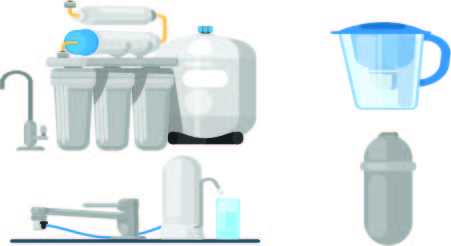In-home Water Filtration Options for Household Drinking Water
Some residents have asked about the use of in-home drinking water filtration units for reducing the amount of perfluorinated chemicals (PFAS) in drinking water. Water filtration units that use granulated activated carbon (GAC, also called charcoal filters) and reverse osmosis (RO) can be effective in removing these chemicals from water.
Activated carbon (charcoal) water filters are made from porous charcoal that attracts and holds chemicals. These filters remove chemicals from the water as it passes through the filter.
Reverse osmosis (RO) units push your water through a semipermeable membrane, which is about as thick as cellophane. The membrane filters the chemicals out of the water.
Both of these water filtration options can be used as point of use or point of entry systems.
GAC and RO can be used as either point of use systems or point of entry systems.
Point of use systems (POUs) attach at the point where your water is dispensed. These can be installed at your drinking water tap or your refrigerator’s water dispenser. POU charcoal filtered water pitchers or water bottles are also available as more economical options.
Point of entry systems (POEs) are water filtration systems that are installed at your home’s main waterline and filter the water used throughout your home. POE systems can be more costly than POU options.

Examples of in-home drinking water filtration units. Top left to bottom right: RO tap unit, charcoal filter water pitcher, charcoal filter tap unit, and refrigerator water filter.
Things to Consider
- Look for an NSF, UL, Water Quality Association certification.
- When considering which unit to purchase, look for the Water Quality Association certification. To earn certification, a manufacturer must undergo testing to confirm that the unit meets all chemical reduction claims and is structurally sound. Units that are labeled as effective for removing pesticides (such as Aldrin) and volatile organic compounds should also be effective for PFOA and PFAS.
- Change the filters periodically. Your water filtration unit must be maintained for it to continue to be effective. Follow all maintenance schedules provided in the manufacturer’s owner’s manual. The more you use your water filtration unit, and the more water you run through it, the more frequently you will need to change your filter. The characteristics of your water (hardness, temperature, etc.) also may affect how frequently you need to change your filters or service your unit.

Where to Get More Information
Technical References
- Minnesota Department of Health July 2008 MDH Evaluation of Point of Use Water treatment Devices for Perfluorochemcial Removal Final Report-Summary 6 pp.
- Anumol T, Bradley C, Merel S and Snyder S (2015) Point of Use Devices for Attenuation of Trace Organic Compounds in Water Journal of American Water Works Association September 2015 107:9.
- Cummings L, Matarazzo A, Nelson N, Sickels F and Storms C (2015) Recommendation on Perfluorinated Compound Treatment Options for Drinking Water. New Jersey Drinking Water Quality Institute Treatment Subcommittee June 2015 12pp.
- Dudley L, Arevalo E and Knappe D (2015) Removal of Perfluoroakyl Substances by PAC Adsorption and Anion Exchange Water Research Foundation Web Report #4344 ISBN 978-1-60753-226-8 129pp.